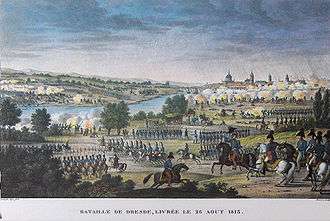Battle of Dresden
| Battle of Dresden | |||||||
|---|---|---|---|---|---|---|---|
| Part of the War of the Sixth Coalition | |||||||
 Battle of Dresden | |||||||
| |||||||
| Belligerents | |||||||
|
|
| ||||||
| Commanders and leaders | |||||||
|
|
| ||||||
| Strength | |||||||
| 135,000 | 214,000 | ||||||
| Casualties and losses | |||||||
| 10,000 dead or wounded |
38,000 dead, wounded, or captured, 40 guns | ||||||

The Battle of Dresden (26–27 August 1813) was a major engagement of the Napoleonic Wars. The battle took place around the city of Dresden in modern-day Germany. With the recent addition of Austria, the Sixth Coalition felt emboldened in their quest to kick the French out of Central Europe. Despite being heavily outnumbered, French forces under Napoleon scored a modest victory against the Allied army led by Field Marshal Schwarzenberg. However, Napoleon's victory did not lead to the collapse of the coalition, and the lack of effective French cavalry units precluded a major pursuit. A few days after the battle, the Allies surrounded and captured a French corps at the Battle of Kulm.
Prelude
On 16 August, Napoleon had sent Marshal Saint-Cyr's corps to fortify and hold Dresden in order to hinder allied movements and to serve as a possible base for his own manoeuvres. He planned to strike against the interior lines of his enemies and defeat them in detail, before they could combine their full strength. He had some 300,000 men and 800 cannons against allied forces totaling over 450,000 and 1200 cannons. But the Coalition avoided battle with Napoleon himself, choosing to attack his subordinate commanders instead (see the Trachenberg Plan). On 23 August, at the Battle of Grossbeeren, south of Berlin, Crown Prince Charles of Sweden (formerly French Marshal Bernadotte, Napoleon's own Marshal) defeated his old comrade Marshal Oudinot. And on 26 August, Prussian Marshal Blücher defeated Marshal MacDonald at the Katzbach.
Battle
On the same day as Katzbach, Karl Philipp Fürst zu Schwarzenberg, the commander of the Austrian force of over 200,000 men of the Austrian Army of Bohemia and accompanied by Francis II, Alexander I, and Frederick William III, attacked Saint-Cyr. In Dresden, French infantry manned the various redoubts and defensive positions. They hoped to last long enough for reinforcements to arrive. Sure enough, they got their wish. Napoleon arrived quickly and unexpectedly with reinforcements to repel this assault on the city. French counterattacks on the Great Garden in the southeast and on the allied center were successful, and by nightfall the French had regained almost all of Saint-Cyr's original positions. Although outnumbered three to two, Napoleon attacked the following morning (27 August), turned the allied left flank, and won an impressive tactical victory. The flooded Weisseritz cut the left wing of the Allied army, commanded by Johann von Klenau and Ignaz Gyulai, from the main body. Marshal Joachim Murat took advantage of this isolation and inflicted heavy losses on the Austrians.[1] A French participant observed, "Murat.... cut off from the Austrian army Klenau's corps, hurling himself upon it at the head of the carabineers and cuirassiers. .... Nearly all his [Klenau's] battalions were compelled to lay down their arms, and two other divisions of infantry shared their fate."[2] Of Klenau's force, Lieutenant Field Marshal Joseph, Baron von Mesko de Felsö-Kubiny's division of five infantry regiments was surrounded and captured by Murat's cavalry, which amounted to approximately 13,000 men, and 15 colours.[3] Gyulai's divisions also suffered serious losses when they were attacked by Murat's cavalry during a rainstorm. With damp flints and powder, their muskets would not fire and many battalions became an easy prey to the French cuirassiers and dragoons.
However, Napoleon's failure to follow up on his success allowed Schwarzenberg to withdraw and narrowly escape encirclement. The Coalition had lost some 38,000 men and 40 guns. French casualties totaled around 10,000. Some of Napoleon's officers noted he was "suffering from a violent colic, which had been brought on by the cold rain, to which he had been exposed during the whole of the battle."[4]
Aftermath
On 27 August, General Vandamme received orders to advance on Pirna and bridge the Elbe there. This was accomplished in a pouring rain, without disturbing the Russians drawn up on the heights of Zehista. This advance by Vandamme resulted in the Battle of Kulm three days later. Interestingly Napoleon's old rival Jean Victor Marie Moreau who had only recently returned from his banishment from the United States was talking to the Tsar (who wished to see Napoleon defeated) and was mortally wounded in the battle and died later on 2 September in Louny.
Hoffman
The author and composer E. T. A. Hoffmann happened to be in Dresden during the battle, being at the time employed by a locally based orchestra. On 22 August, after the end of the armistice, the Hoffmann Family was forced to relocate from their pleasant house in the suburbs into the town. During the next few days, as the battle raged, they experienced the ongoing bombardments. As Hoffman later recounted, many people were killed by bombs directly in front of him. After the main battle was over, he visited the gory battlefield. His account can be found in Vision auf dem Schlachtfeld bei Dresden.
References
- ↑ Chandler, The Campaigns of Napoleon, pp. 910–911.
- ↑ Jean Baptiste Antoine Marcellin de Marbot. The Memoirs of General Baron De Marbot, Volume II,, Chapter 23. Electronic book widely available.
- ↑ Smith, p. 445. Mesko was wounded, and retired the following year. Kurdna and Smith, Mesko.
- ↑ "Memoirs of the Duke of Rovigo". Peterswald.
External links
Coordinates: 51°02′N 13°44′E / 51.033°N 13.733°E